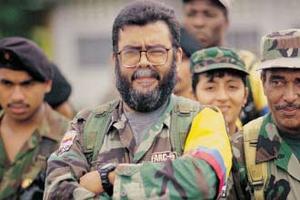 On November 4, the top leader of the insurgent Revolutionary Armed Forces of Colombia (FARC), Alfonso Cano, was killed in combat with elite units of the Colombian army, raising questions about the country’s on-going conflict. As I have written in previous blogs and elsewhere, the state’s military strategy focuses on eliminating “high value targets,” (such as top FARC leaders) with the ultimate goal of dismantling the insurgency. The U.S. and Israeli governments introduced the strategy in Colombia, where it was adopted as standard practice.
On November 4, the top leader of the insurgent Revolutionary Armed Forces of Colombia (FARC), Alfonso Cano, was killed in combat with elite units of the Colombian army, raising questions about the country’s on-going conflict. As I have written in previous blogs and elsewhere, the state’s military strategy focuses on eliminating “high value targets,” (such as top FARC leaders) with the ultimate goal of dismantling the insurgency. The U.S. and Israeli governments introduced the strategy in Colombia, where it was adopted as standard practice.
Cano is not the first on the government’s hit list to be killed as part of this strategy. Military intelligence, high-tech surveillance, and smart weapons provided by foreign militaries aided in the killing of Raul Reyes in 2008 and Jorge Briceño Suárez or Mono Jojoy in 2010. Reyes and Jojoy were members of the secretariat, the FARC’s highest ruling body, and were also considered “high value targets” by the Colombian government.
I address this fundamental issue in the following open letter to President Juan Manuel Santos:
Dear President Santos,
I am sure you and your military are celebrating a victory after killing the leader of the FARC, and the subsequent boost it lent to troop morale, which had suffered due to military set backs in the recent past. Cano’s death is undoubtedly an historic event. However, his assassination may have far-reaching consequences on the dynamics of the conflict and the possibilities for peace.
Mr. President, my question to you is this: If the FARC and the ELN vanish and you manage to “shut them down,” would this put an end to the long struggle of poor peasants in Colombia, a country where 35% live in the countryside and many depend on subsistence farming? The raison d’être of these insurgencies is a fairer distribution of land. The current consolidation of land ownership is scandalous. Colombia’s land GINI coefficient is 0.87%, which is to say that nearly 1% of the population owns all rural land, making Colombia one of the countries with the highest land concentration in the world.
The core question is whether winning this war militarily, without any meaningful land reform, will bring peace to you and the country, or simply lead to a continuation of violence. Consider the cases of El Salvador and Guatemala. Both failed to introduce meaningful socioeconomic reforms that could have strengthened their states’ distributive capacity. El Salvador now has the highest homicide rate in the world, at 60 murders per 100,000 people. Guatemala is not far behind, with 58 murders per 100,000 people.
I hope these examples alert you to what is awaiting Colombia if you do not introduce meaningful socioeconomic reform to redress the woefully inequitable distribution of land and income in your country.
Another important issue, which I am sure you may have thought about and which I am having trouble understanding, is how to justify the high cost on the military. For example, the Colombian military is en route to numbering nearly 500,000 men and women in the fight against about 10,000 insurgents from the FARC and the National Liberation Army (ELN). This is a shocking ratio of 50 soldiers per insurgent.
The enormous cost of such a leviathan army is quite possibly the largest in Latin America. It constitutes 6% of the Colombian GNP, or nearly $12 billion a year, if you factor the interest on debt payments and other military expenditures. That means Colombia’s military spending per capita is $260 per Colombian, based on a total population of 46 million people. Even more striking is the per capita cost for fighting 10,000 rebels—$1,200,000 per insurgent. I am sure that it would be much cheaper to introduce meaningful land reform, Mr. President.
Mr. President, with all due respect, Economics 101 will tell you that this war is neither cost effective nor the best way to allocate limited resources in a country where almost half of the population lives in poverty. Moreover, it will tell you that the enormous cost of sustaining such a leviathan military has long been met by diminished returns.
Granted, on one hand, you have introduced new measures in Congress like the “Land Restitution Law,” which might return a fraction of the 6 million hectares usurped by the paramilitaries and their associates over the last 20 years. Alongside this law your government has proposed other encouraging constitutional reforms— welcomed indications that you might be interested in preparing for an eventual negotiation of the ongoing internal conflict. They are, however, insufficient measures.
On the other hand, I suspect that you may be strengthening your negotiating hand by killing commander Cano. This should help you manage the most recalcitrant elements inside and outside the military, including former president Álvaro Uribe Vélez, cattle ranchers, and paramilitaries.
Mr. President, some weeks before his passing, commander Cano sent you a message that the FARC is interested in pursuing a peace agreement. At face value, like most things in the conflict, targeting him is a double-edge sword. One might ask: are you targeting the message or the messenger? Maybe both?
In any case, your choices are clear: either you capitalize on your current (temporary) victory and push for a negotiated peace agreement, or you squander the opportunity and prolong this very costly conflict. It is your call.
For more from Nazih Richani's blog, Colombian Cuadernos, visit nacla.org/blog/cuadernos-colombianos, or see the NACLA Report July/August 2009, "Coercion Incorporated: Paramilitary Colombia."

